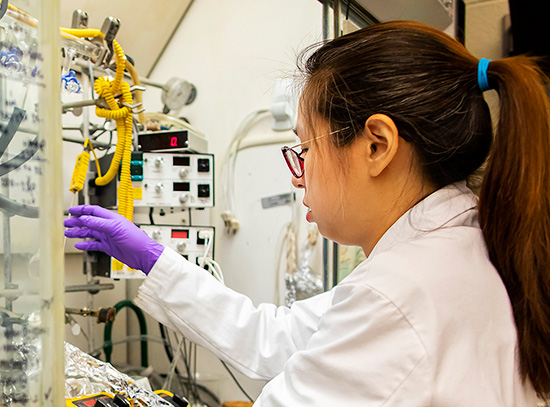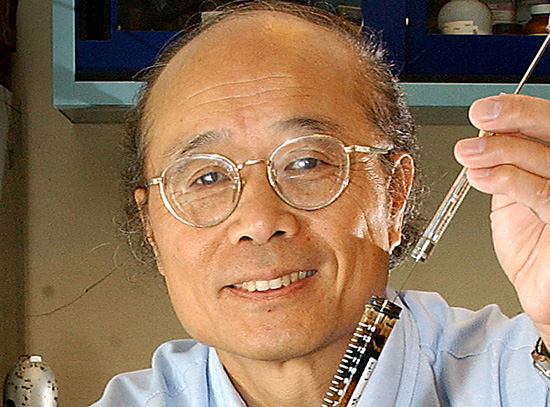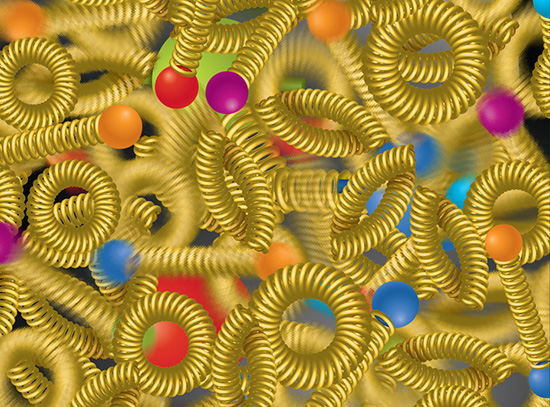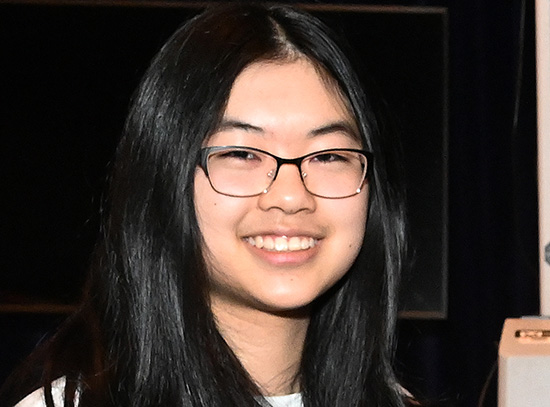Maria Zawadowicz: Offering Expertise In Aerosol Measurement
Brookhaven Lab atmospheric chemist serves on ARM's User Executive Committee and joins outreach efforts
January 30, 2024
By Corydon Ireland, Staff Writer, Pacific Northwest National Laboratory
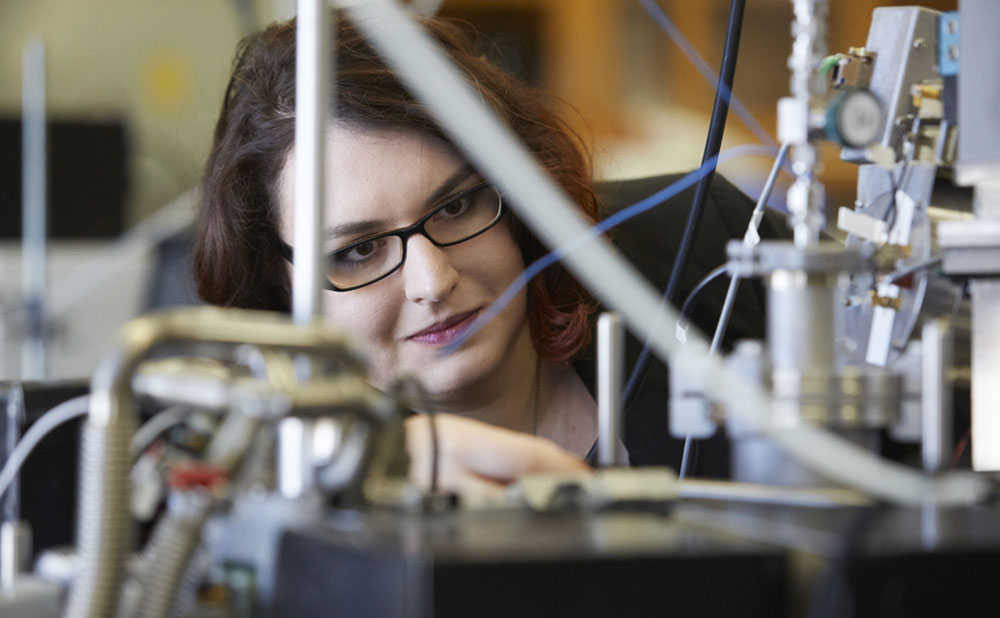 enlarge
enlarge
As a PhD student at the Massachusetts Institute of Technology (MIT), Maria Zawadowicz was part of the Program in Atmospheres, Oceans and Climate, where she devised a way to differentiate bioaerosols in the atmosphere from inorganic particulates such as dust. Photo is courtesy of MIT.
The following profile was published on the U.S. Department of Energy's Atmospheric Radiation Measurement (ARM) user facilty website on Jan. 18, 2024.
As a child growing up in mountainous southeastern Poland, Maria Zawadowicz (za-WAD-o-wits) took frequent hikes with her mother on winding grassland trails capped by wide vistas of sky. The experience awakened her to nature’s magic and mysteries.
Today, Zawadowicz is an assistant environmental scientist at Brookhaven National Laboratory (BNL) in New York. Her research specialty concerns one of those enduring mysteries of nature: What are aerosols made of?
“I study very small microphysical processes on this very minute scale,” says Zawadowicz. “But they, in turn, influence very large cloud systems so large they can be seen from space.”
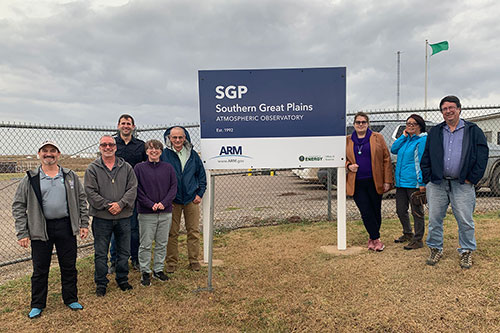 enlarge
enlarge
Zawadowicz (third from right) was among those who attended an October 2023 ARM User Executive Committee workshop at the Southern Great Plains (SGP) atmospheric observatory in Oklahoma. Photo is by SGP Operations Manager John Schatz.
Aerosol research requires detailed data on atmospheric processes. For that reason, Zawadowicz is a fan of long-term measurements collected and made freely available by the Atmospheric Radiation Measurement (ARM) user facility.
ARM, a U.S. Department of Energy (DOE) Office of Science user facility, has more than 5 petabytes of continuous measurements of atmospheric processes. Some of the data date to 1992.
In addition to using ARM data, Zawadowicz oversees an ARM aerosol instrument.
“I so enjoy working for ARM, and I think that it has a lot to offer as a user facility,” says Zawadowicz. “The volume of data is unique among all the other agencies.”
In late 2022, deepening her ties to ARM, Zawadowicz was elected to its User Executive Committee (UEC), a leadership advisory body. She is now in the second year of her four-year term.
Representing ARM’s user community
Zawadowicz is the UEC’s science theme representative for land-atmosphere interactions and aerosol measurements. In addition, she chairs a subgroup on measurement uncertainty and communicating calibrations while belonging to another on undergraduate engagement and diversity.
Outreach to undergraduates and early career scientists, she says, “is a big current focus of the UEC.”
Strategizing that outreach was part of a UEC workshop on October 24 and 25, 2023. About half the advisory group attended in person at ARM’s Southern Great Plains atmospheric observatory in Oklahoma, and others joined online.
“It was wonderful to just network and focus solely on UEC,” says Zawadowicz. “We got a lot done.”
A workshop summary is in progress.
In honor of Earth Day 2022, Zawadowicz takes a moment to talk on camera about her research and its important contributions to our understanding of the atmosphere.
Aerosol chemical speciation
At BNL, Zawadowicz designs and makes aerosol field instruments. Some of them use onsite mass spectrometry to analyze the chemistry of aerosols.
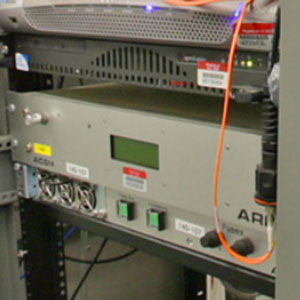 enlarge
enlarge
Zawadowicz is ARM's lead instrument mentor for the aerosol chemical speciation monitor. This compact mass spectrometer captures the chemical composition of submicron particles.
She is also ARM’s lead instrument mentor for the aerosol chemical speciation monitor (ACSM), a compact mass spectrometer designed to capture the chemical composition of submicron particles.
Zawadowicz’s expertise with the ACSM explains, in part, her role in an ongoing project sponsored by DOE’s Atmospheric System Research (ASR) program. She is a co-investigator for the Process-level AdvancementS of Climate through Cloud and Aerosol Lifecycle Studies (PASCCALS) Science Focus Area.
PASCCALS is investigating the multifaceted magnitude of how aerosols and clouds influence the Earth’s energy budget: how much solar radiation reaches the surface, a question in line with ASR’s mission to support research that improves climate models.
The PASCCALS investigation requires deep dives into cloud condensation nuclei, aerosols linked to biomass burning, cloud processes in the atmospheric boundary layer, and the microphysics of clouds that create storms.
PASCCALS has a fifth theme: to study the interaction of aerosols and convective storm clouds during ARM’s TRACER field campaign. The name stands for the TRacking Aerosol Convection interactions ExpeRiment (TRACER), a 2021–2022 campaign in the Houston, Texas, area. Her PASCCALS research centers primarily on analyzing TRACER aerosol data.
Traveling for work
From 2017 to 2023, Zawadowicz took part in three ARM campaigns in addition to TRACER.
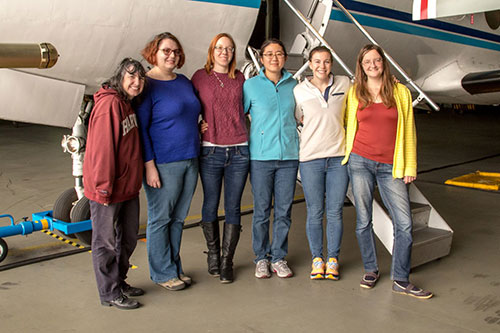 enlarge
enlarge
Zawadowicz (second from left) joined other scientists on aircraft research flights during ARM's Aerosol and Cloud Experiments in the Eastern North Atlantic (ACE-ENA) field campaign. This campaign in the Azores featured two intensive operational periods in 2017 and 2018. Photo is by Jason Tomlinson, Pacific Northwest National Laboratory.
Her first was in the Azores, an island chain west of mainland Portugal. The Aerosol and Cloud Experiments in the Eastern North Atlantic (ACE-ENA) campaign included what she called “the thrill of airborne research” during two intensive operational periods in 2017 and 2018.
After TRACER came a campaign in the Rocky Mountains called the Surface Atmosphere Integrated Field Laboratory (SAIL). Zawadowicz received support from DOE to analyze vertical profiles of the atmosphere collected by ARM tethered balloon systems during the 21-month SAIL campaign in Colorado through a joint proposal to ARM and another DOE Office of Science user facility, the Environmental Molecular Sciences Laboratory (EMSL).
Zawadowicz’s most recent fieldwork took place in La Jolla, California, during the Eastern Pacific Cloud Aerosol Precipitation Experiment (EPCAPE), which wraps up in February 2024.
“In general,” says Zawadowicz, “I’m really interested in utilizing data from ARM campaigns.”
For most campaigns, she is onsite to set up aerosol instruments, returns to calibrate them periodically, and then takes them down to recalibrate again. In between, Zawadowicz and her team back at BNL monitor the instruments’ performance remotely.
“I love fieldwork,” says Zawadowicz. “It’s the sort of real-world component that is very satisfying. We study the environment. You can’t just do that in a lab.”
A major aerosol honor
“Maria is one of the most enthusiastic early career researchers I have had the pleasure to work with,” says BNL’s Michael Jensen, the UEC’s current vice-chair, TRACER’s lead scientist, and one of four PASCCALS principal investigators. “She brings her particular expertise in atmospheric chemistry and the measurement and analysis of the chemical composition of aerosol particles both in the laboratory and during field campaigns.”
"I love fieldwork. It’s the sort of real-world component that is very satisfying. We study the environment. You can’t just do that in a lab."
— Maria Zawadowicz
Praise recently arrived for Zawadowicz from another source. In October 2023, she was named vice-chair of the instrumentation working group for the American Association for Aerosol Research (AAAR).
After a one-year term, she will become the group’s chair.
AAAR was founded in 1982 to address the growing realization that aerosols are essential to understanding the complex vastness of the atmosphere and the fate of particles that affect human health.
Working groups help organize AAAR’s annual meetings by providing suggestions on tutorials, plenary speakers, session topics, and special symposia.
The yearly meetings draw hundreds of scientists from all over the world. Their research spans the kind of aerosols Zawadowicz studies—as well as those from car tires, chicken coops, sneezes, ship plumes, and biomass burning.
Wildfires, thunderstorms, and an aerobiome
During AAAR’s 41st annual conference in October 2023, Zawadowicz dived into the potpourri of hundreds of presentations and posters, highlighting three projects of her own.
One project is in collaboration with atmospheric chemist John Shilling at Pacific Northwest National Laboratory (PNNL) in Washington state to investigate gases that arise from wildfires and become aerosols. The researchers use an environmental chamber at PNNL to study two representative classes of these gases, along with the properties of the aerosols they form.
Zawadowicz also presented a poster related to her aerosol characterization work during TRACER. Part of the campaign’s science mission was to study how these tiny particles influence storm initiation and convective cloud life cycles. She was responsible for aerosol chemistry measurements at TRACER’s main and auxiliary sites.
At the American Association for Aerosol Research (AAAR) annual conference in Portland, Oregon, Zawadowicz speaks about her research using aerosol data from ARM's TRacking Aerosol Convection interactions ExpeRiment (TRACER).
In another AAAR presentation, Zawadowicz shared a few initial results from her study of the aerobiome present during SAIL. An aerobiome is the collective microscopic life in a particular air space, including fungi, bacteria, viruses, pollen grains, and other bits of organic matter.
Zawadowicz and her collaborators, using space on ARM’s tethered balloon system, deployed instruments designed to measure particle fluorescence. When excited by a laser, particles give off light. Measuring this emitted light is a proxy for biological material in the atmosphere.
In December 2023, during the annual fall meeting of the American Geophysical Union (AGU), Zawadowicz joined other aerosol and cloud researchers in a turn from the field to the laboratory.
She is part of an international team of 12 universities, national laboratories, and industry partners funded by DOE and the National Science Foundation investigating potential pathways for a future cloud chamber facility. Preliminary results show that a convection-cloud chamber 10 meters (32 feet) high would enable controlled studies of the microphysics of aerosols and cloud systems in turbulent conditions.
Curiosity crossed with nature
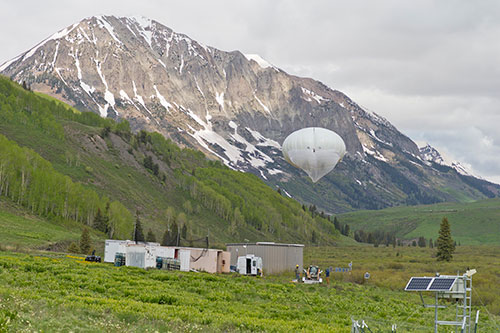 enlarge
enlarge
During the Surface Atmosphere Integrated Field Laboratory (SAIL) campaign in Colorado, Zawadowicz and her team investigated the local aerobiome with instruments mounted on an ARM tethered balloon system like the one in the June 2023 image above. Photo is by Nathan Bilow.
Zawadowicz’s childhood home was Ustrzyki Dolne, a town of about 10,000 residents in southeastern Poland. The town sits in a region of the Carpathian Mountains near western Ukraine.
Frequent walks along local trails with her mother, a health care worker, “made me appreciate the natural world,” says Zawadowicz.
Her father, an auto mechanic, died when she was 6 but passed along, she thinks, a facility for tinkering and machine engineering.
At age 13, Zawadowicz and her mother moved to suburban Chicago, Illinois, where the charms of Lake Michigan helped keep her love of nature alive.
As an undergraduate at nearby Lake Forest College (B.A., chemistry and physics, 2012), Zawadowicz joined the lab of atmospheric chemist Lori Del Negro, an enthusiastic veteran of fieldwork. Lake Forest, says Zawadowicz, is where her dreams, aspirations, and interests fell into place.
In the Del Negro lab, students built small devices to sample air toxins. An interest in designing, making, and running instruments followed Zawadowicz to the Massachusetts Institute of Technology (PhD, atmospheric chemistry, 2017).
A breakthrough paper
Zawadowicz joined the university’s Program in Atmospheres, Oceans and Climate, directed by atmospheric chemistry professor Dan Cziczo, where she devised a way to differentiate bioaerosols in the atmosphere from inorganic particulates such as dust.
Her breakthrough 2017 paper established that bioaerosols are 25 to 50 times more rare than previous estimates. Her methods were part mathematics (a machine learning algorithm) and part machine (a single-particle mass spectrometer).
As a postdoctoral researcher at PNNL (2017–2020), Zawadowicz spent most of her time at the Atmospheric Measurements Laboratory. It is home to the environmental chamber she is using with PNNL’s Shilling for her wildfire aerosol work.
Today, at BNL, Zawadowicz knows every nut, bolt, stack, and dial of the ARM Aerosol Observing System. This system includes the ACSM, her workhorse instrument. It allows her to study small aerosols, which influence large fields of clouds.
Says Zawadowicz: “Our work makes an impact across scales.”
2024-21689 | INT/EXT | Newsroom




